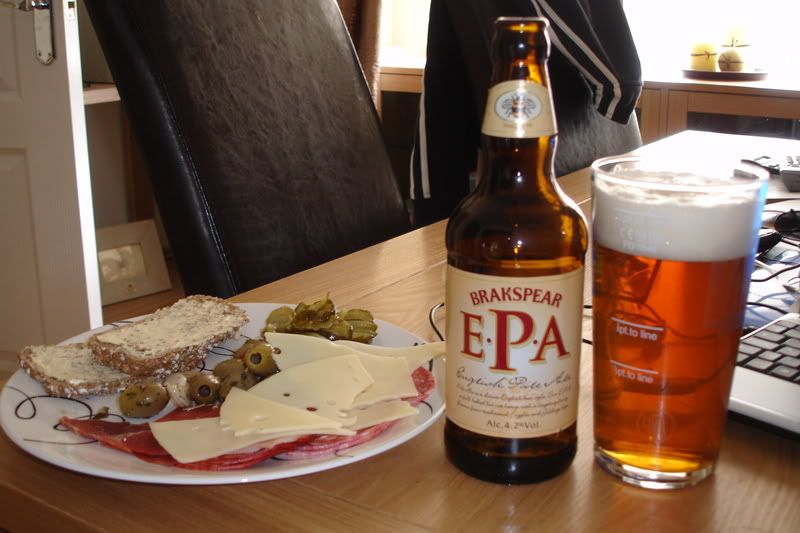 Decent English ale brings out the pie eater in me. When I get that English hop flavour and complex yeast contribution I have a hankering for traditional English fare comprising savoury meats and ploughman's lunches. Everything works so damn well. I have my father to blame for this need. His food of choice with a pint of ale is a cheese and onion sandwich, which we eventually managed to track down for him at the British Beer Festival. There was a protracted period of time when he feared a total absence of his favourite ale supplement, but thankfully discovered a small stall in the corner of the cavernous Earl's Court venue where a very busy man was bisecting French rolls and stuffing them with mature cheddar and fresh onion. He was a very contented man for the rest of the festival. So when I opened this bottle of Brakspear EPA I felt compelled to complement it with the food I love so much. You have no doubt noticed that there is a distinct lack of pie and pasties on the plate in the photo, but I did the best I could given the limits of my fridge contents, and must declare myself very happy with the resulting collaboration. I greatly enjoyed Brakspear's Bitter and was very keen to try their EPA hoping that it would be a step up the flavour intensity ladder. In this respect it didn't disappoint having satisfying English hop character and the familiar complex malt and yeast flavour that I can't pin down. I tried the Brakspear Triple last year in my pre blog days and was very happy with the muted tones of the their bitter which was triple like to a degree. The EPA represents the middle ground, I suppose, and gives you everything you could hope for from a bottled pale ale.
Decent English ale brings out the pie eater in me. When I get that English hop flavour and complex yeast contribution I have a hankering for traditional English fare comprising savoury meats and ploughman's lunches. Everything works so damn well. I have my father to blame for this need. His food of choice with a pint of ale is a cheese and onion sandwich, which we eventually managed to track down for him at the British Beer Festival. There was a protracted period of time when he feared a total absence of his favourite ale supplement, but thankfully discovered a small stall in the corner of the cavernous Earl's Court venue where a very busy man was bisecting French rolls and stuffing them with mature cheddar and fresh onion. He was a very contented man for the rest of the festival. So when I opened this bottle of Brakspear EPA I felt compelled to complement it with the food I love so much. You have no doubt noticed that there is a distinct lack of pie and pasties on the plate in the photo, but I did the best I could given the limits of my fridge contents, and must declare myself very happy with the resulting collaboration. I greatly enjoyed Brakspear's Bitter and was very keen to try their EPA hoping that it would be a step up the flavour intensity ladder. In this respect it didn't disappoint having satisfying English hop character and the familiar complex malt and yeast flavour that I can't pin down. I tried the Brakspear Triple last year in my pre blog days and was very happy with the muted tones of the their bitter which was triple like to a degree. The EPA represents the middle ground, I suppose, and gives you everything you could hope for from a bottled pale ale.
Tuesday, September 23, 2008
Pies, Pasties and Pickle
 Decent English ale brings out the pie eater in me. When I get that English hop flavour and complex yeast contribution I have a hankering for traditional English fare comprising savoury meats and ploughman's lunches. Everything works so damn well. I have my father to blame for this need. His food of choice with a pint of ale is a cheese and onion sandwich, which we eventually managed to track down for him at the British Beer Festival. There was a protracted period of time when he feared a total absence of his favourite ale supplement, but thankfully discovered a small stall in the corner of the cavernous Earl's Court venue where a very busy man was bisecting French rolls and stuffing them with mature cheddar and fresh onion. He was a very contented man for the rest of the festival. So when I opened this bottle of Brakspear EPA I felt compelled to complement it with the food I love so much. You have no doubt noticed that there is a distinct lack of pie and pasties on the plate in the photo, but I did the best I could given the limits of my fridge contents, and must declare myself very happy with the resulting collaboration. I greatly enjoyed Brakspear's Bitter and was very keen to try their EPA hoping that it would be a step up the flavour intensity ladder. In this respect it didn't disappoint having satisfying English hop character and the familiar complex malt and yeast flavour that I can't pin down. I tried the Brakspear Triple last year in my pre blog days and was very happy with the muted tones of the their bitter which was triple like to a degree. The EPA represents the middle ground, I suppose, and gives you everything you could hope for from a bottled pale ale.
Decent English ale brings out the pie eater in me. When I get that English hop flavour and complex yeast contribution I have a hankering for traditional English fare comprising savoury meats and ploughman's lunches. Everything works so damn well. I have my father to blame for this need. His food of choice with a pint of ale is a cheese and onion sandwich, which we eventually managed to track down for him at the British Beer Festival. There was a protracted period of time when he feared a total absence of his favourite ale supplement, but thankfully discovered a small stall in the corner of the cavernous Earl's Court venue where a very busy man was bisecting French rolls and stuffing them with mature cheddar and fresh onion. He was a very contented man for the rest of the festival. So when I opened this bottle of Brakspear EPA I felt compelled to complement it with the food I love so much. You have no doubt noticed that there is a distinct lack of pie and pasties on the plate in the photo, but I did the best I could given the limits of my fridge contents, and must declare myself very happy with the resulting collaboration. I greatly enjoyed Brakspear's Bitter and was very keen to try their EPA hoping that it would be a step up the flavour intensity ladder. In this respect it didn't disappoint having satisfying English hop character and the familiar complex malt and yeast flavour that I can't pin down. I tried the Brakspear Triple last year in my pre blog days and was very happy with the muted tones of the their bitter which was triple like to a degree. The EPA represents the middle ground, I suppose, and gives you everything you could hope for from a bottled pale ale.
Saturday, September 20, 2008
Not for the pot, but the glass
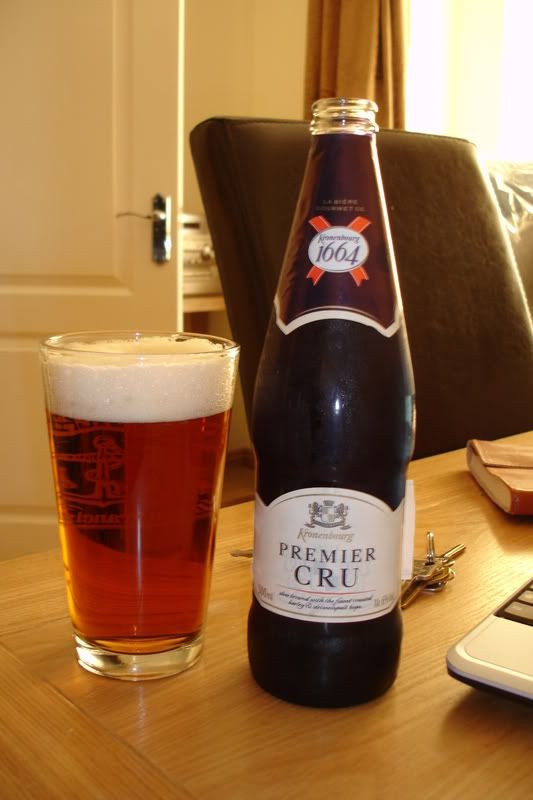 I usually cook with French beer and then use the tiny bottles they serve it in for yeast propagation or as the perfect nip bottle for strong beer. I'm not sure of any greater insult to throw at a brewery but it's often hard to find anything good at all to say about the average French beer. Invariably they are lagers with little flavour and plenty of gas and Kronenbourg is no exception, however this brewery's Premier Cruz is a cut above the normal stuff, so much so that I plan to hunt down another bottle very soon to have in reserve. It is a very pleasing amber colour and its hefty 6% abv gives a wonderful fullness, padded out further by caramel and toffee. The bottle suggests that there is apple in there too but I can't spot it. There is some lovely hop character that rounds everything off nicely. I am going to Paris on honeymoon next month and wasn't terribly hopeful about the beer scene while there because I had no intention of dragging my wife around in search of craft beer. This tasty drop from one of the major French brewers will keep me quite contented if it is available. I won't be cooking with this one. In fact I'll be hunting down some food to have with it.
I usually cook with French beer and then use the tiny bottles they serve it in for yeast propagation or as the perfect nip bottle for strong beer. I'm not sure of any greater insult to throw at a brewery but it's often hard to find anything good at all to say about the average French beer. Invariably they are lagers with little flavour and plenty of gas and Kronenbourg is no exception, however this brewery's Premier Cruz is a cut above the normal stuff, so much so that I plan to hunt down another bottle very soon to have in reserve. It is a very pleasing amber colour and its hefty 6% abv gives a wonderful fullness, padded out further by caramel and toffee. The bottle suggests that there is apple in there too but I can't spot it. There is some lovely hop character that rounds everything off nicely. I am going to Paris on honeymoon next month and wasn't terribly hopeful about the beer scene while there because I had no intention of dragging my wife around in search of craft beer. This tasty drop from one of the major French brewers will keep me quite contented if it is available. I won't be cooking with this one. In fact I'll be hunting down some food to have with it.
Friday, September 19, 2008
Copenhagan - European Beer Festival
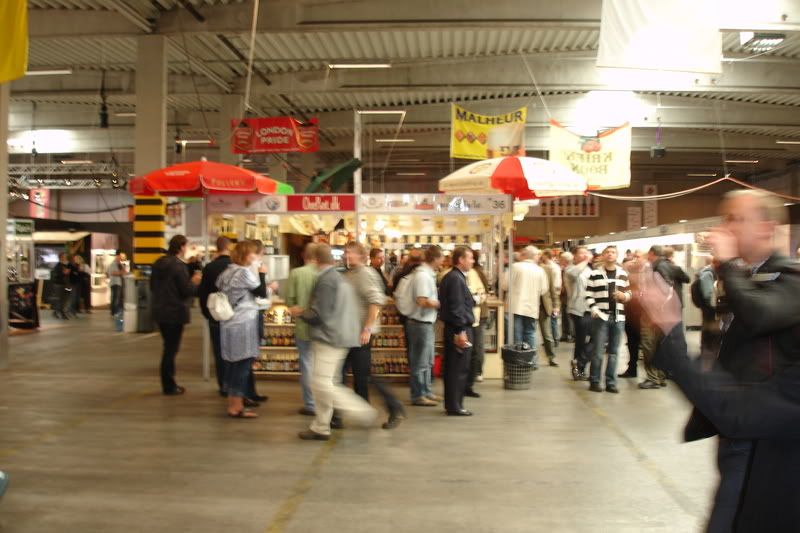 I must confess that my preparation for this event began on the flight over, seated next to The Beer Nut while he made his hit list of essential beers. I was quite prepared to follow his lead in this respect and promptly fell into his slip stream when we arrived at the venue. His count sits at 112 for the three days and happily I can say that mine is very similar, but with far fewer notes, well, none to be exact, but the best of them are still fresh in my mind.
I must confess that my preparation for this event began on the flight over, seated next to The Beer Nut while he made his hit list of essential beers. I was quite prepared to follow his lead in this respect and promptly fell into his slip stream when we arrived at the venue. His count sits at 112 for the three days and happily I can say that mine is very similar, but with far fewer notes, well, none to be exact, but the best of them are still fresh in my mind.This event was superbly run by those involved, and no doubt the more civilised drinking culture that prevails in Denmark negated the need for me to step over vomit at any point during the weekend. The 100ml measures were ample for a great many of the beers on offer which seemed to effortlessly exceed 6 or 7% abv and would have done for the average Irish punter who would have opted for a pint and nothing less. The Danes are doing amazing things with beer and have fully embraced the American brewing culture with an endless supply of imperial stouts and IPAs and I feel somewhat sad that this kind of brewing is not really feasible in Ireland because of excessive excise levies and the attitude of the average Irish drinker and publicans. Beer and breweries of note for me included:
- Bryggeriet Djaevlbrg (The Brewery Devil's Brew) who brewed the wonderful Schopenhauer's Vilje, a wonderful example of the better balanced beer on offer with full malt and toffee along with wonderful hops. Their Nekron and Son of Nekron were a stout and porter that I could drink by the gallon and dearly wish they might turn up in Ireland and give a certain dark beer here a thorough hiding.
- Norrebro Bryghus had on offer a vast selection of beer which is all the more remarkable because according to The Beer Nut this brew pub runs a tiny set up that fits into a corner of their bar. Beers of note here include their New York Lager, not because it was an outstanding beer but more to do with the notion that a lager from New York has become a style of beer. What do the people at the BJCP think about that? Stevns CCC was an amazing guest beer available at their stall which was supposed to be a kriek of sorts but the cherries weren't too up front. Either way, it was delicious and was the beer I chose to finish up the weekend's events on.
- The boys at Mikeller were completely unknown to me, but you'd be hard pressed to forget these guys. Apart from their good beer which included a very tart red current lambic and an intense single hopped Simcoe IPA that could have done with a little toning down on the hop front, these lads were really enjoying themselves. Various wigs were donned and placards were carried around the festival floor along with a countdown timer for special beers they had on offer. One of these timed release beers was a blueberry lambic that I missed out on which was shame because I looked forward to trying a beer that reminded me of muffins.
- Not Danish but Norwegian were the Nogne O boys who sported a minimalist stall, but the same cannot be s
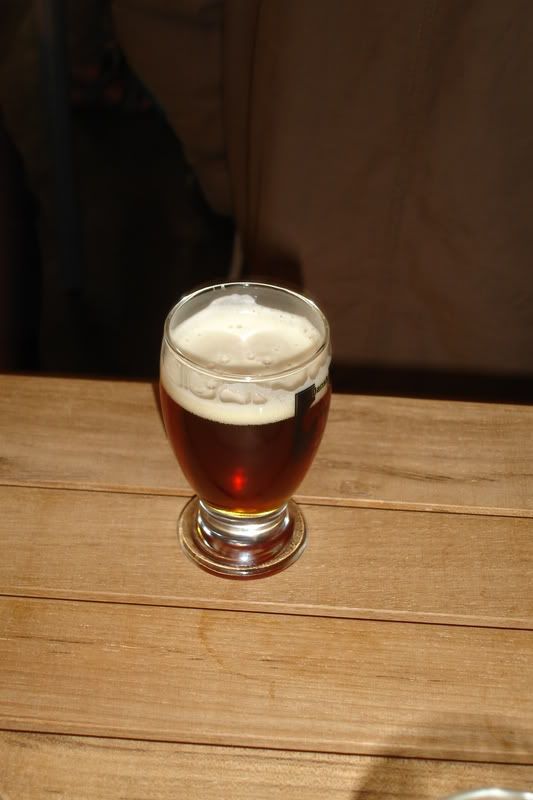 aid for their beer. Dark Horizon Second Edition was a remarkable Imperial Stout packing 17.5% and resembling port more than beer. It had a funny way of disappearing up the back of your throat and out your nose which gave it very little length. Nogne O Porter was one of the few beers outside of the British Pavilion available on cask and beat all of the British porters available hands down. Tangerine Dream was an example of one of the better heavily hopped beer available, and curious to me because it did indeed smell and taste of oranges, but I wondered did the brewers smell the beer afterwards and name it or were they confident of producing such a beer from the outset?
aid for their beer. Dark Horizon Second Edition was a remarkable Imperial Stout packing 17.5% and resembling port more than beer. It had a funny way of disappearing up the back of your throat and out your nose which gave it very little length. Nogne O Porter was one of the few beers outside of the British Pavilion available on cask and beat all of the British porters available hands down. Tangerine Dream was an example of one of the better heavily hopped beer available, and curious to me because it did indeed smell and taste of oranges, but I wondered did the brewers smell the beer afterwards and name it or were they confident of producing such a beer from the outset?
There were a great many other beers during my time in Copenhagen and enjoyed pretty much all of them, even the asparagus beer from a brewery I cannot recall the name of. It stank to high heaven of the green shoot but really didn't taste bad at all.
If you love beer you must attend this event. No excuses.
Saturday, September 6, 2008
Biscuit Beer
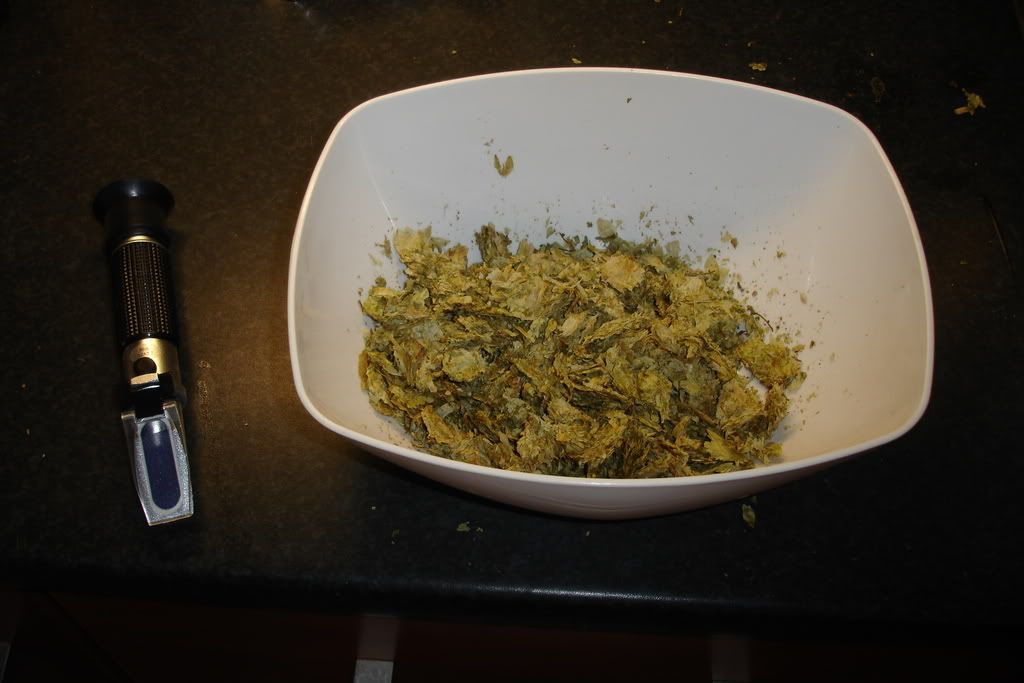 This will likely be the last beer I brew before my wedding as the next few weeks will be hectic what with wedding plans and brewing assignments. I planned a very straightforward ale today with only pale and crystal malt, but when I took a look through my supplies I spotted some biscuit malt, the presence of which had slipped my mind. I decided to add it to the grist for today's brew with the hope that it will provide a fuller malt aspect to the beer. Initial tasting of the sweet wort certainly suggests this will be a rich beer, so I hopped it quite well to balance the malt. This one should be English through and through because coupled with the English malts, I added a good measure of Challenger and Northdown along with a British ale yeast strain from Wyeast.
This will likely be the last beer I brew before my wedding as the next few weeks will be hectic what with wedding plans and brewing assignments. I planned a very straightforward ale today with only pale and crystal malt, but when I took a look through my supplies I spotted some biscuit malt, the presence of which had slipped my mind. I decided to add it to the grist for today's brew with the hope that it will provide a fuller malt aspect to the beer. Initial tasting of the sweet wort certainly suggests this will be a rich beer, so I hopped it quite well to balance the malt. This one should be English through and through because coupled with the English malts, I added a good measure of Challenger and Northdown along with a British ale yeast strain from Wyeast.My yeast propagation endeavours are working a treat, and saving me money which is an added perk. The plate stirrer method I employ for making starters is producing a vast mass of cells for pitching which enables me to make parallel starters by pouring off a few hundreds millilitres of starter into bottles and storing them in the fridge. These in turn can be used to make further starters thus enabling me to get a number of brews from one yeast pack. This only works up to a point because yeast don't really like sitting in an alcohol infused medium for too long and will start to mutate or just plain kick the bucket. A bit of reading around has suggested the little fellas will happily sit in the fridge for around 6 months before I have to start worrying about a detrimental drop in viability. There are quite a number of other methods to store yeast in the long term involving nutrient plates, slopes and deep freezing, but I'm not prepared to go down that route just yet. It isn't really necessary and the yeast cultures I used are commercially available and easily replaced. I suppose if I developed a particular house strain that I liked I could attempt to preserve it but that seems most unlikely from the home brew perspective.
Friday, September 5, 2008
Session #19
 I'm fond of German beer. No two ways about it. It's not my favourite type of beer despite its many manifestation, but without it I doubt very much that I would have discovered just what beer can be. Germany's easy drinking wheat beers were my first step into craft beer, and I quickly moved along to other styles. German beer seemed like the obvious choice because I swallowed the German purity law hook line a sinker and felt somewhat smug in my new choice of clearly superior beer. I have come to realise that just about all craft brewers from every country brew beer to the highest standard and German beer isn't special in this regard and believe it or not, Germany has its fair share of second rate beer too. Recently at the Great British Beer Festival my eyes were opened to just how good German can be when I tried some cask helles and wheat beer which were superbly conditioned and made me realise that we really don't get the best of German beer from the bottles available in Ireland.
I'm fond of German beer. No two ways about it. It's not my favourite type of beer despite its many manifestation, but without it I doubt very much that I would have discovered just what beer can be. Germany's easy drinking wheat beers were my first step into craft beer, and I quickly moved along to other styles. German beer seemed like the obvious choice because I swallowed the German purity law hook line a sinker and felt somewhat smug in my new choice of clearly superior beer. I have come to realise that just about all craft brewers from every country brew beer to the highest standard and German beer isn't special in this regard and believe it or not, Germany has its fair share of second rate beer too. Recently at the Great British Beer Festival my eyes were opened to just how good German can be when I tried some cask helles and wheat beer which were superbly conditioned and made me realise that we really don't get the best of German beer from the bottles available in Ireland.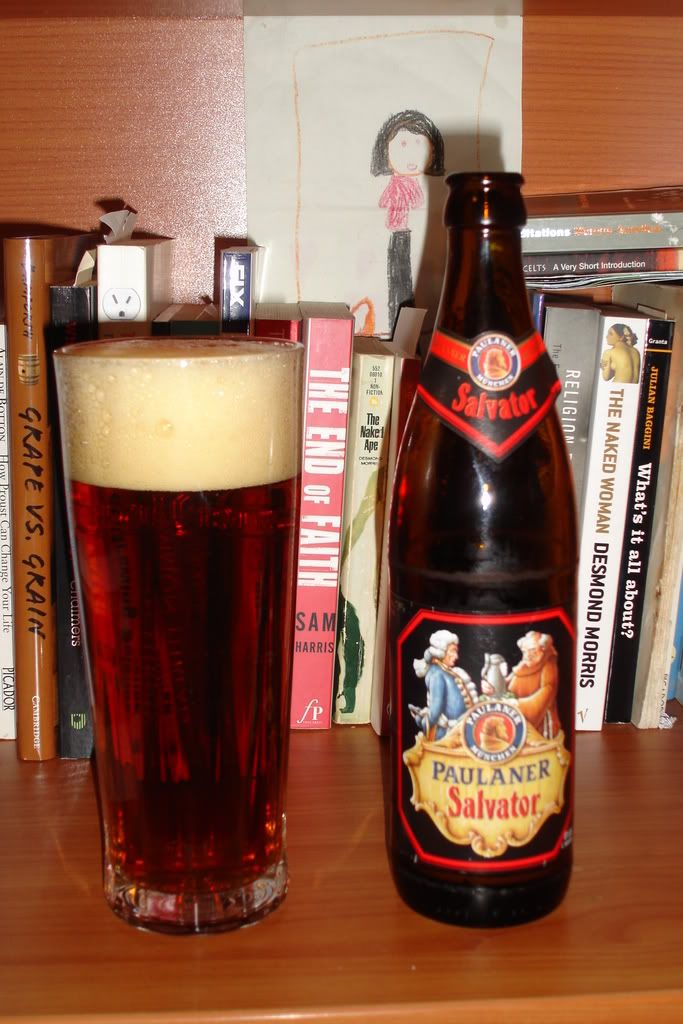
Coincidentally I stumbled across some Salvator the other day, a beer that I first tried when my brother brought me back a bottle from his wanders around Europe. I adored it back then, around 4 years ago, and couldn't get the stuff anywhere in Ireland at the time. I asked one of the better providers about it and he referred to it as 'that beer' suggesting it had some manner of cult aspect to it. It's readily available now but sadly my most recent experience with it wasn't as revelatory as my first encounter, but it still stood up in the sticky toffee stakes and I rather enjoyed it. More and more German beer is arriving in Ireland, mainly in the form of weisse beer and lager which is excellent news for us beer enthusiasts but I must confess that I pass up on the German stuff if there is some new British or American ales available, and this makes me feel a little guilty because this blog and my love of beer wouldn't exist if it wasn't for my early forays into German beer.
Thursday, September 4, 2008
It'll taste better than it looks, I promise
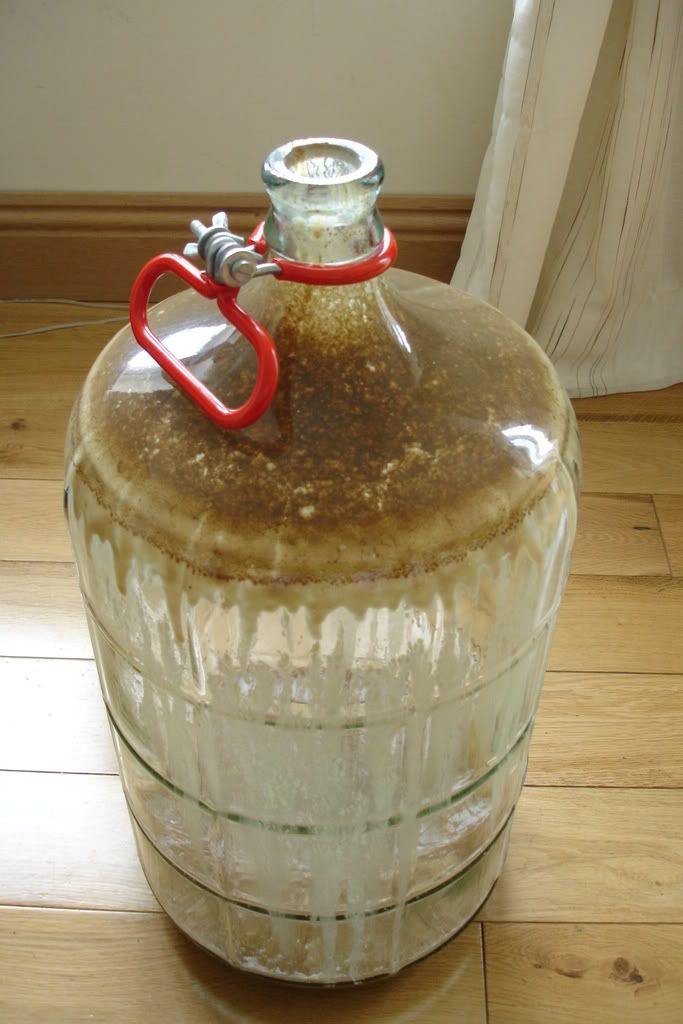 I broke out the mash tun again last week. I was keen to do so after the disaster of my last two batches. As a result of those mishaps I haven't had any success in the brew house since my very tasty Industrial Stout and wouldn't generally brew another dark beer quite so soon, but my recent Sierra Nevada Stout encounter tipped the balance and edged me to brew another porter. I have a theory that a great deal of the American dark beer I drink has a fair measure of Vienna or Munich malts which contribute to the rich fullness that is the most striking aspect of these beers. The porter I put together is something of a hybrid because I love English porter, the best of which is often typified with a brown malt contribution, while American porters and stouts are hopped a little more and use richer malts. When formulating the recipe I opted for equal measures of brown and Munich malt but in the end opted to half the brown malt contribution to make it a little more American, but then at the last moment threw in a handful of East Kent Goldings to the boil, which makes it more American, I suppose, but the hops are English. In the end it really doesn't matter. All I'm looking for is a full flavoured porter which I think I might have achieved, judging by the sneaky taste I had while transferring it to secondary fermentation. The unappealing gunk in the carboy above is the stuff left after primary fermentation. Brewing is a messy business with lots of funky stuff produced, but the finished product is usually good, hard as it may be to believe from the above picture.
I broke out the mash tun again last week. I was keen to do so after the disaster of my last two batches. As a result of those mishaps I haven't had any success in the brew house since my very tasty Industrial Stout and wouldn't generally brew another dark beer quite so soon, but my recent Sierra Nevada Stout encounter tipped the balance and edged me to brew another porter. I have a theory that a great deal of the American dark beer I drink has a fair measure of Vienna or Munich malts which contribute to the rich fullness that is the most striking aspect of these beers. The porter I put together is something of a hybrid because I love English porter, the best of which is often typified with a brown malt contribution, while American porters and stouts are hopped a little more and use richer malts. When formulating the recipe I opted for equal measures of brown and Munich malt but in the end opted to half the brown malt contribution to make it a little more American, but then at the last moment threw in a handful of East Kent Goldings to the boil, which makes it more American, I suppose, but the hops are English. In the end it really doesn't matter. All I'm looking for is a full flavoured porter which I think I might have achieved, judging by the sneaky taste I had while transferring it to secondary fermentation. The unappealing gunk in the carboy above is the stuff left after primary fermentation. Brewing is a messy business with lots of funky stuff produced, but the finished product is usually good, hard as it may be to believe from the above picture.It's really very easy to over think beer recipes, when in fact the simplest concoctions will produce excellent results providing the other aspects of the process are looked after, in particular the fermentation. Most home brewers do not give enough regard to their yeast, which is a pity because they often put a great deal of time and thought into sourcing the ingredients and blending them is such a manner as to produce the beer they long for. In general, home brewers under pitch their yeast because they cannot produce sufficient cell mass in the average starter,while at the ot
 her end of the scale some massively over pitch by racking their most recent brew onto the yeast cake of a previous one. Neither of these are conducive to nice flavours in the beer, but we often have no choice but to work within the restrictive environment of our kitchens and garden sheds. This latest brew was my first attempt at pitching a specific amount of cells per millilitre of wort, but counting the cells proved more difficult than I thought, mainly because I allowed the yeast to sediment and it produced a very firm slurry which couldn't be readily re-dispersed into solution. This of course ruined any chance of counting the yeast in the starter because it was no longer homogeneous. I am determined to persevere with is because pitching the correct amount of yeast is fundamental to good beer production, and I plan to figure out how to do it.
her end of the scale some massively over pitch by racking their most recent brew onto the yeast cake of a previous one. Neither of these are conducive to nice flavours in the beer, but we often have no choice but to work within the restrictive environment of our kitchens and garden sheds. This latest brew was my first attempt at pitching a specific amount of cells per millilitre of wort, but counting the cells proved more difficult than I thought, mainly because I allowed the yeast to sediment and it produced a very firm slurry which couldn't be readily re-dispersed into solution. This of course ruined any chance of counting the yeast in the starter because it was no longer homogeneous. I am determined to persevere with is because pitching the correct amount of yeast is fundamental to good beer production, and I plan to figure out how to do it.
Subscribe to:
Posts (Atom)